
A One Month Push-Up Training Program for Beginners (3 Days Per Week)

The push-up is a foundational bodyweight exercise that everyone can benefit from doing. Besides being fundamental for building upper body strength, power, and size, the push-up also comes with a ton of great variations that can provide a lot of training benefits.
However, in order to perform some of the more advanced push-up variations, then the basic push-up needs to be an exercise and skill on lock. This means that a foundation of form and strength need to be built for the pushing muscles that are required to perform great push-ups.
In this article, we're going to provide you with a one-month program to tackle the push-up and bring you up to speed for performing multiple clean, consecutive reps.
- Push-Up Progressions
- One-Month Push-Up Program
- Push-Up Guide
- Push-Up FAQs
Before diving into the program, we highly suggest checking out the push-up guide at the bottom of this article.
Push-Up Progressions
Before diving into program, we're going to cover two useful push-up progressions that everyone should understand, as they'll be used throughout the four week program. These two progressions will help build a foundation of strength and form to improve push-ups.
Assisted Push-Ups
The first push-up progression is the single and double knee assisted push-up. For this push-up variation, you'll assume a traditional push-up position and place either one or both knees on the ground based on your strength and fitness level.
This variation is useful because it helps lighten the load that needs to be pushed and it's going to help us accumulate pressing volume throughout the four weeks.
- Double Knee: Great option for true beginners.
- Single-Knee: Slightly more advanced, pay attention to the hips and ensure they're square when using this variation.
Tempo and Paused Push-Ups
The second progressions worth noting are the tempo and paused push-up. This modification will stem from the push-ups variation being performed and it will change the speed in which your execute the movement.
- Tempo: Modifying the lowering and pressing portion of the movement.
- Paused: Stopping at a specific position and holding for a time based goal.
Beginner Push-Up Program
The goal of this program is for it to be implemented into your current training routine. The workouts are short and should either 1) supplement your current training days, or 2) be performed on off days as an active recovery session.
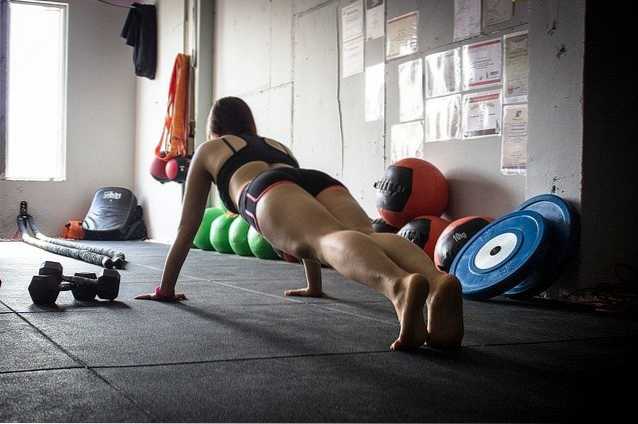
Program Guidelines
Rest Days and Equipment: This program works best if it's run with one day of rest in-between each workout day, so avoid performing them all back-to-back-to-back with four days of rest in-between sessions. Good frequency options include:
- Monday, Wednesday, Friday
- Tuesday, Thursday, Saturday
Also, this program includes no equipment so it can be used anytime anywhere.
Rest Times In-Between Sets: Try to take between 1-2 minutes of rest in-between sets. However, this can shortened or lengthened based on your energy levels and schedule. If you can shorten rest times and perform perfect reps, then feel free to do so!
Assisted Modifications: Scale your assisted push-ups by proficient reps. For example, if one week you perform two knees down and complete all of the reps, then switch to one knee for one, two, or all of the sets the following week. Use your strength and execution as a scale for the type of assistance used and needed.
Pre-Program: Perform as many normal push-ups as possible until form breaks down. No shame here. If it's 0, then we start there and build! Take a day of rest, then start on the 4-week program below.

Day 1: Push-Up Volume Accumulation
- Assisted Push-Up: 3 x 8-10 reps
- Perform these with either one or two knees on the ground. Choose based on your starting strength and fitness level.
- Assisted Tempo Push-Up: 2 x 6 reps
- Perform an assisted push-up with a 4-second lowering phase. Count to four in your head while lowering, then either A) press back up as normal, or B) get back to your starting position by any means.
- Decline Push-Up: 3 x 6-8 reps
- Find a bench, staircase, or piece of furniture to perform a push-up on. The goal should be “feeling” this in the lower pec region.
- Extended Plank: 4 x 20-25 seconds
- Week 1: 20-25 seconds, Week 2: 30-35 seconds, Week 3: 35-40 seconds, Week 4: 45-50 seconds
Day 2: Lockout and Tricep Strength
- Assisted Close-Grip Push-Ups: 4 x 8 reps
- Perform an assisted push-up with the hands shoulder width apart or slightly closer to create a triceps focus.
- Half Range of Motion Push-Ups: 2 x 5 reps
- For these, assume a normal push-up position and perform a half-rep with a 3-second lowering phase, then lockout as normal. The goal is targeting the triceps.
- Bodyweight Skull Crushers: 3 x 8 reps
- Perform these on a wall or couch. Choose a height that is feasible for 8 reps. Check out this in-depth guide for a bodyweight skull crusher how-to.
- Up and Down Planks: 3 x 10-20 reps (see below for weekly rep scheme)
- Week 1: 10-12 reps, Week 2: 14 reps, Week 3: 16-18 reps, Week 4: 18-20 reps
Day 3: Pec and Deltoid Strength
- Wide Grip Assisted Push-Up: 3 x 8-10 reps
- Position the hands roughly one hand's widths wider that your normal push-up setup.
- Assisted Pause to Dead Stop Push: 3 x 5 reps
- Perform a 3-second lowering phase, pause when the arms hit 90 degrees for 1-second, then lower the body to the ground counting to 2-seconds. Once the body makes contact with the ground, assume your normal starting position and get up by any means.
- Lateral Delt Raise: 3 x 10-12 reps
- Grab a milk jug, phone book, or backpack with some weight in it and perform lateral delt raises.
- Prone YTWs: 3 Rounds
- Lie flat on the ground and perform three rounds of YTWs. Check out this video for an example!
After you've completed this program, take two days of rest and prepare for another test!
Post-Program: Perform as many reps as possible without form breakdown. How much did you improve?
Push-Up Guide
There's more than meets the eye with the push-up. Hip alignment, hand and feet position, and so much more need to be accounted for to make the push-up as effective as possible.
To help clean up your form and to start working towards picture perfect push-ups, check out the step-by-step push-up guide below.
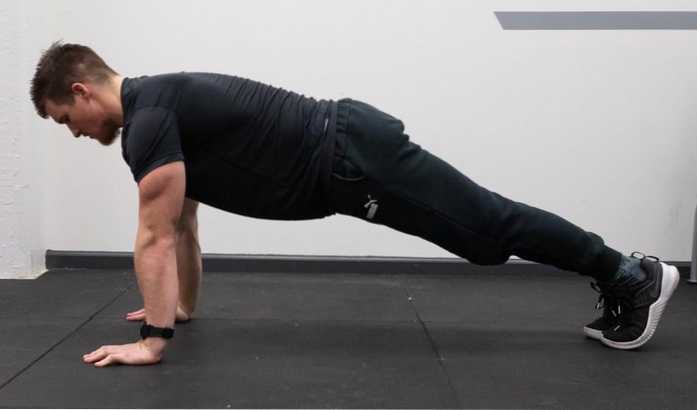
1. Assume a Plank Position
To perform the push-up, start at the top of the plank position with the back flat. The arms should be fully extended with the hands directly underneath the shoulder joint. The feet and thighs should be pressed actively together.
Often, beginners will place their hands too far forwards in front of them. Be sure to place the hands under the shoulder joint, maybe even slightly back towards your hips.
Coach's Tip: Assume a plank with the torso rigid and back flat. The head should remain in a neutral position.
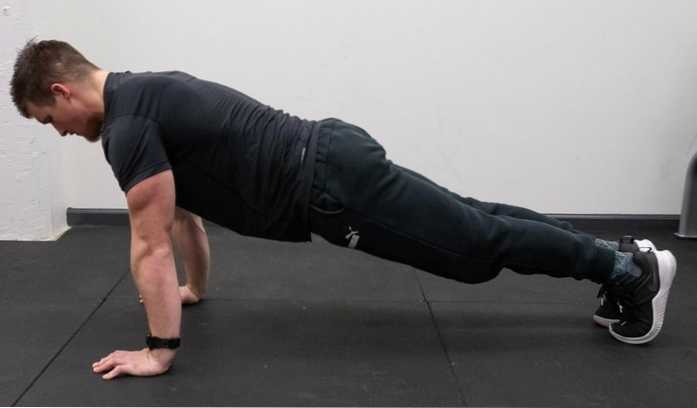
2. Set Your Back
While in the plank position, actively pull your shoulder blades together to create tension in the upper back. This will help stabilize the shoulder girdle and ensure proper stability in the lowering phase of the push-up.
Set the back by pulling the shoulder blades towards the hips and extending the upper back. Be sure to not let the hips sag or lower back hyperextend while in this position.
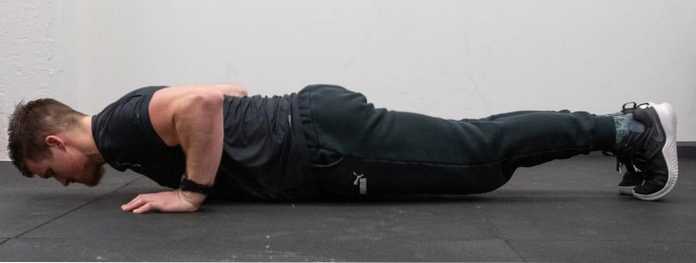
3. Pull Yourself to the Floor
Once you are set, think about pulling your elbows to the back, similar to a row position. This will help activate the upper back muscles and provide you with stability as you approach the bottom of the push-up.
Do not let you head or shoulders slouch forwards towards the floor. Rather, think about pulling your sternum in between your hands.
Coach's Tip: The thighs, hips, and chest should all make contact on the floor at the same time. If these are out of order or do not occur at the same time, this may suggest sagging of the hips and/or hyperextension in the lower back.
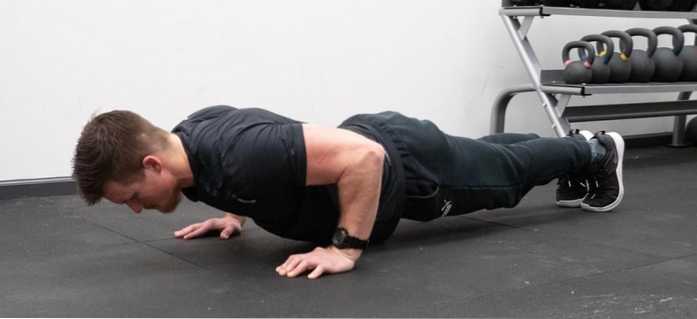
4. Reach Into the Floor
Once you have touched the floor, press yourself away and upwards by trying to reach your hands into the floor. By thinking about reaching, rather than pushing, you can reframe the movement to have the body find stability and strength from the upper back.
Push yourself away from the floor, and focus on keeping tension in the upper back.
Coach's Tip: Stay rigid in the torso and be sure to not let the hips sag in the upwards movement of the push-up.
Beginner Push-Up FAQs
What muscles does the push-up work?
The primary muscles involved in the push-up are the pectoralis major and triceps. There is also involvement with the core, upper back muscles, and serratus anterior throughout the push-up.
Can the push-up replace the bench press?
It depends on your goals, but the push-up is a viable exercise for matching bench press adaptations when intensity and volume are accounted for. Like every exercise, there needs to a form of progressive overload that is dictated by the adaptation (power, mass, strength, etc.) when using the push-up.
What's the best push-up progression exercise?
One of the better no equipment push-up progressions is the assisted push-up. This push-up variation will entail placing one or both knees on the ground to decrease total weight pressed in this exercise.
Can the push-up make your arms bigger?
Yes! The push-up will strengthen the triceps and likely cause some hypertrophy with this muscle group. Since the triceps make up roughly 2/3 of the arm, then there will likely be some arm size increase.
What does the push-up do?
The push-up trains the body with horizontal pressing, so it will increase strength and mass with the muscles and body parts involved in this movement pattern.
Let Us Know How You Did
If you tackle this program and improve your push-ups, let us know you did in the comments below. Also, let us know how you added this program into your current training and provide feedback about what worked and what didn't.
Feature image from Flamingo Images / Shutterstock



Nimeni nu a comentat acest articol încă.